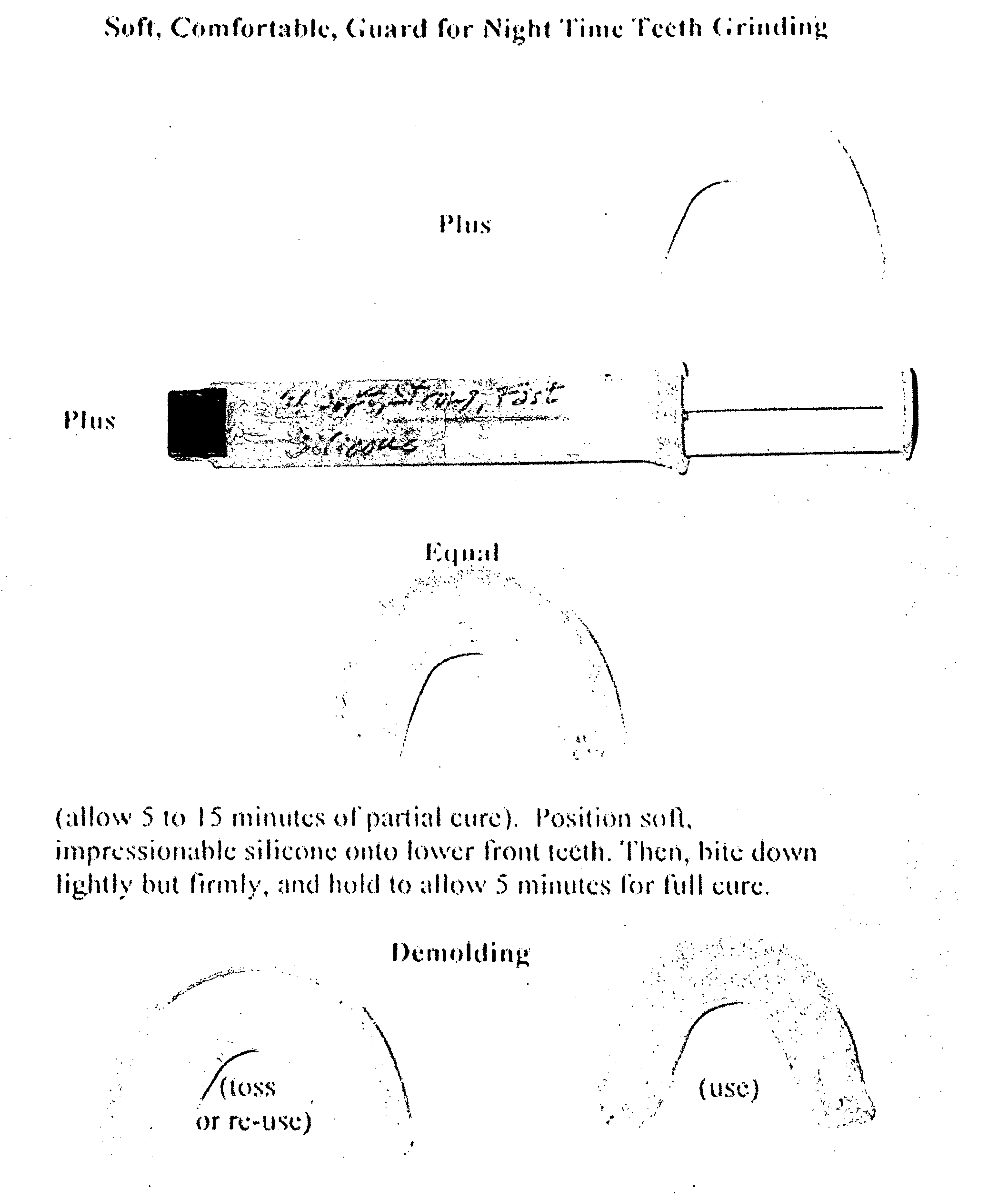Flexible prosthodontic device
a prosthodontic device and flexible technology, applied in the field of flexible prosthodontic devices, can solve the problems of excessive wear of teeth, jaw pain, headache, and teeth sensitiveness, and achieve the effects of reducing the risk of tooth loss
- Summary
- Abstract
- Description
- Claims
- Application Information
AI Technical Summary
Problems solved by technology
Method used
Image
Examples
example 1
[0028] Place a U-shaped 1-mm thick polypropylene (PP) non-woven insert into a flat-bottomed trough of a U-shaped foam tray. Set up tray with insert in such a manner as to have the lowest edge of the two open ends of the tray be level and about 1 mm below the edge of the front wall of the foam tray. This positioning is easily achieved by placing the foam tray between two edges of two ¼ inch thick plates which are set about 25 mm apart. The tray is rested between these plates. Insure that the insert is laying flat down in the trough of the tray. Dispense into the tray enough liquid silicone rubber material so as to have the liquid cover the insert completely and to about 1 mm below the front edge of the tray.
[0029] Allow the silicone to cure partially, approximately 15 minutes. Without delay, flip the tray with its contents over and place it carefully into position with the teeth barely touching the silicone. Once the position is deemed satisfactory, bite straight down onto the devic...
example 2
[0032] Place a U-shaped leather insert into a flat-bottomed trough of a U-shaped foam tray. Set up tray with insert in such a manner as to have the lowest edge of the two open ends of the tray be level and about 1 mm below the edge of the front wall of the foam tray. This positioning is easily achieved by placing the foam tray between two edges of two ¼ inch thick plates which are set about 25 mm apart. The tray is rested between these plates. Insure that the insert is laying flat down in the trough of the tray. Dispense into the tray enough liquid silicone rubber material so as to have the liquid cover the insert completely and to about 1 mm below the front edge of the tray.
[0033] Allow the silicone to cure partially, approximately 15 minutes. Without delay, flip the tray with its contents over and place it carefully into position with the teeth barely touching the silicone. Once the position is deemed satisfactory, bite straight down onto the device to impress the lower teeth int...
example 3
[0036] Place a U-shaped polyethylene / vinyl acetate (EVA) insert into a flat-bottomed trough of a U-shaped foam tray. Set up tray with insert in such a manner as to have the lowest edge of the two open ends of the tray be level and about 1 mm below the edge of the front wall of the foam tray. This positioning is easily achieved by placing the foam tray between two edges of two ¼ inch thick plates which are set about 25 mm apart. The tray is rested between these plates. Insure that the insert is laying flat down in the trough of the tray. Dispense into the tray enough liquid silicone rubber material so as to have the liquid cover the insert completely and to about 1 mm below the front edge of the tray.
[0037] Allow the silicone to cure partially, approximately 15 minutes. Without delay, flip the tray with its contents over and place it carefully into position with the teeth barely touching the silicone. Once the position is deemed satisfactory, bite straight down onto the device to im...
PUM
 Login to View More
Login to View More Abstract
Description
Claims
Application Information
 Login to View More
Login to View More - R&D
- Intellectual Property
- Life Sciences
- Materials
- Tech Scout
- Unparalleled Data Quality
- Higher Quality Content
- 60% Fewer Hallucinations
Browse by: Latest US Patents, China's latest patents, Technical Efficacy Thesaurus, Application Domain, Technology Topic, Popular Technical Reports.
© 2025 PatSnap. All rights reserved.Legal|Privacy policy|Modern Slavery Act Transparency Statement|Sitemap|About US| Contact US: help@patsnap.com


